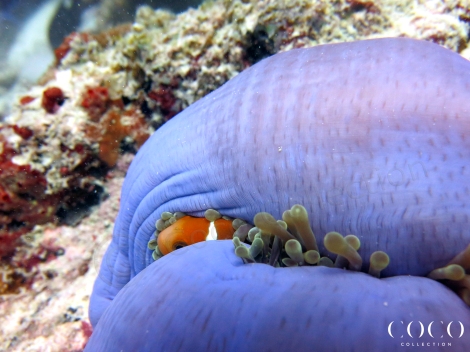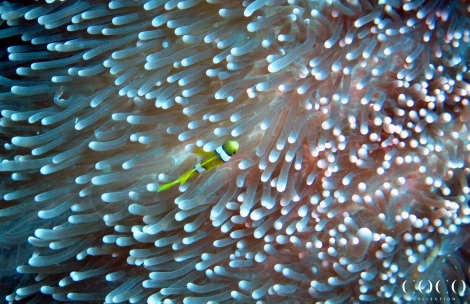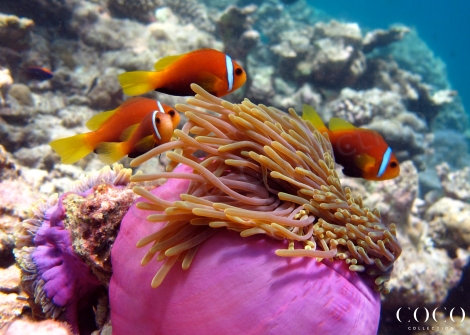Filippo Scacchi is one of our Marine Biology Interns at Coco Bodu Hithi and he has a lot to share with you about the fascinating life of the clown fish. Keep reading to learn about his encounters with this beautiful fish we all know and love as “Nemo”.
Whenever I go on a snorkeling or diving excursion, the clown fish never fails to capture my attention. Among one of the most colorful reef fish, the clown fish gained a lot of popularity after the movie “Finding Nemo”. Although they are quite common and spotted often, I can never resist the urge to shoot some pictures while they hang around the house reef of Coco Bodu Hithi, Coco Privé Kuda Hithi and Coco Palm Dhuni Kolhu.
Even though there are many species of clown fish all over the world, there’s one that can be found only in Maldives and Sri Lanka: the Maldives Anemone fish. This species is very easy to recognize, thanks to its bright orange color and a single white stripe running down vertically just behind the eye.
Clown fish usually live in symbiosis with anemones, watching and protecting the anemone from predators and parasites, while in return helping to aerate the anemone with their movements. On the other hand, the anemone protects the clown fish by acting as a safe nest for it to live in, shielding the clown fish from its predators using stinging tentacles that the clown fish is immune against. The clown fish always rush in to the security of the anemone when I approach them during snorkeling and then they stick their head out to check if I left!

A Maldives Anemonefish hiding in its Magnificent Sea Anemone (Heteractis magnifica) at Coco Bodu Hithi House Reef
There are some peculiar facts that not many of our guests are aware of when it comes to these adorable little fish: At the beginning of the animated film “Finding Nemo”, Marlin and Coral are shown naming their newly laid eggs: Marlin proposes to call half of them “Marlin Junior” and the other half “Coral Junior”. But factually, they should all be named “Marlin Junior” because when little clown fish hatch, they are all males! Being ‘protandrous hermaphrodites’, all Clown Fish are born as males and can become females during their life.

A juvenile Clark’s Anemonefish, (a non-reproductive male) found while snorkeling at Kiufengali reef, Baa Atoll, close by Coco Palm Dhuni Kolhu
A family of clown fish has a dominant female (in the film: “Coral”), a reproductive male (in the film: “Marlin”) and a number of young non-reproductive males. When the dominant female dies, the reproductive male rapidly undergoes a process by which he will become a female. Young males (like “Nemo”) then grow up to become the active male!

Maldives Anemonefish on a sea anemone: the dominant female usually swims on the top, while the reproductive male and the young males stay below. At Coco Palm Dhuni Kolhu House Reef
If you think that the clown fish have a strange reproductive life, think twice because these kind of extreme changes are quite common among reef fish families! Leave a comment for us down below if you learned something new about clown fish from Filippo.



